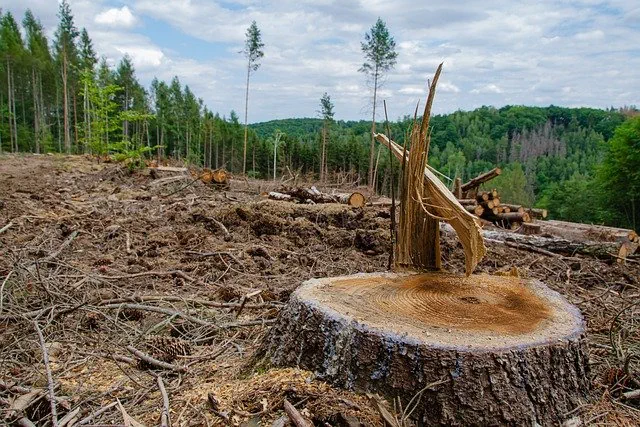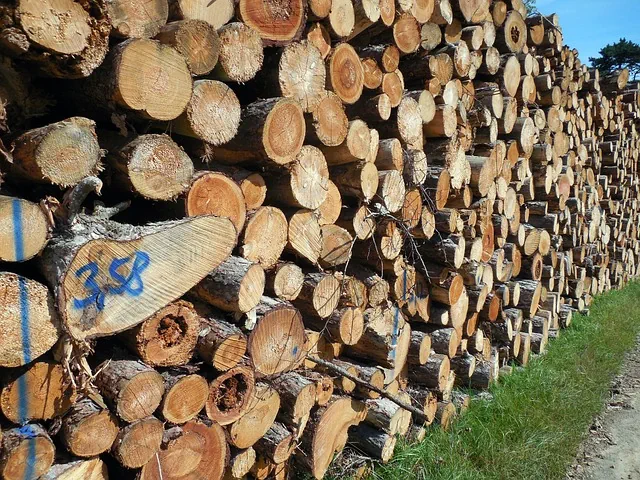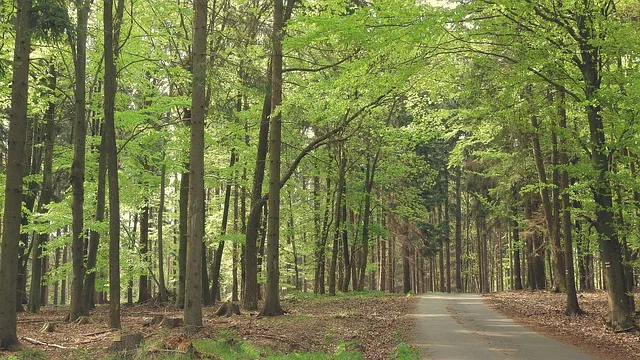![Header banner of 'How Does Deforestation Affect Humans [2022]?'](/post/how-does-deforestation-affect-humans/banner.webp)
How Does Deforestation Affect Humans [2022]?

Table of Contents
According to the UN Global Forest Goals Report of 2021, forests currently cover close to 31% of the global land area. However, only 1.11 billion hectares are covered by native or primary forests that are largely undistributed. Even worse, the world is continually losing its forests at a fierce rate, with about 420 million hectares lost to deforestation since 1990.

Deforestation is a major environmental issue. Pixabay
Trees play a major role in preserving wildlife, reducing the pace of climatic change, and supporting billions of lives. Unfortunately, mass destruction of trees through deforestation continues to sacrifice the long-term benefits of trees in exchange for short-term gains.
What Is Deforestation
Deforestation refers to the clearing, destruction, or removal of standing trees through natural, deliberate, or accidental means. That can happen in any place densely populated by trees or other plant life, although most of it is taking place in the Amazon rainforest. This activity leads to catastrophic weather effects and the destruction of land quality.
The loss of trees can occur due to different reasons, including:
Farming And Ranching
Combined with mining and drilling, farming and livestock grazing accounts for more than half of the total annual deforestation, while wildfire, urbanization, and forestry practices account for the rest. For instance, the world’s oldest tropical forests in Indonesia and Malaysia are cut down to create room for palm oil commercial farming. Clearing forests that are high in biodiversity to practice this type of monoculture farming results in different environmental problems, including wildlife habitat destruction and rapid release of carbon into the air.
Logging Operations
The world’s demand for paper and wood products results in the fall of countless trees every year. Loggers, some acting illegally, also destroy more trees and plantations as they build roads to access remote parts of the forest.

Logging accounts for almost 50% of deforestation in the world. Pixabay
Other Natural and Human Factors
Not all deforestation activities are intentional. Some are caused by different natural and human activities like overgrazing, wildfires, and the growing urban sprawl, which sees land developed into homes.
Importance Of Trees
As the biggest plants on land, trees are a crucial element of our environment. They replenish our oxygen supply, stabilize the soil, store carbon, and shelter the world’s wildlife. Even better, trees provide us with the necessary materials for building tools and shelter.

Trees are an important part of the environment. Pixabay
Trees are essential for life, and they are a natural link to our past, present, and future, considering they’re the oldest living species in the world. As such, it’s crucial to preserve rainforests, trees, and woodlands all over the world to enjoy different benefits, including:
Benefit Our Health
Tree canopies act as a physical filter that traps dust and absorbs pollutants in the air. Each tree removes about 1.7 kilos of pollutants from the air annually. They also reduce noise and offer shade from solar radiation. Studies also show that spending time under a tree improves your mood and lowers blood pressure.
Spending time around trees also helps you focus, as it allows your brain to recover from mental fatigue that results from directing your attention towards normal activities like work or school. Attention fatigue can make it hard for children to control their impulses or pay attention. Fortunately, studies show that kids who spend time around trees and natural vegetation have a reduction in attention fatigue.
Nourish The Environment
Trees consume carbon dioxide to grow and store carbon in their wood to reduce the global warming rate. They also help to reduce wind speeds while colling the air as they lose water. Research also shows that trees can help reduce a city’s temperature by up to seven degrees Celsius. Additionally, trees help to prevent soil erosion and flooding by absorbing thousands of liters of rainwater.
Support Wildlife
From a very early stage, trees host complex microhabitats. When they’re young, they provide habitat and food to various communities of insects, birds, fungi, and lichen. Their trunks provide the hollow cover that species like bats, woodpeckers, and woodboring beetles need to live in after growing. In fact, a single mature oak tree can host over 500 species of animals.
Grow The Economy
Most people are attracted to work, live and invest in places surrounded by green vegetation for various reasons. Research indicates that house prices are 5-18% higher in areas close to mature trees and other tropical vegetation. Additionally, companies benefit from a happier and healthier workforce when there are trees and parks nearby.
Strengthen Communities
Trees encourage local pride and strengthen an area’s distinctive character. Urban woodlands are a great educational resource and can bring people together for activities like birdwatching and walking. Trees are also crucial for children’s play as it allows them to discover their sense of adventure.
Protect Our Future
Soon, the number of people owning homes in cities will outmatch those in the countryside. As such, trees and parks will be a crucial part of our urban life, and hence we must protect them to safeguard the future of cities.
Which Industries Cut The Trees?
While forests are critically important to the environment and must be protected, they’re being degraded rapidly, resulting in carbon loss and several negative impacts on the ecosystem. Deforestation is also among the biggest source of the world’s anthropogenic emissions, resulting in 15% of greenhouse gas emissions.

Several industries are responsible for deforestation - pixabay
Although most people only associate deforestation with food production or agriculture, forest loss can be associated with different commodities’ commercial production. However, cattle, palm oil, soy, and timber remain the top four forest-risk commodities. These four forest-risk commodities are found in lots of value chains across many sectors. In fact, the average company gets 24% of its revenue from these four forest-risk commodities.
Some of the top industries and sectors responsible for deforestation include:
Agriculture
Agriculture is the single biggest cause of deforestation, with commercial agriculture being responsible for the degradation of 40% of the tropic forest. Local subsistence farming also accounts for another 33% of deforestation, as people continue cutting trees to grow crops like soy and palm. People are also clearing forests to get grazing land for their livestock, mainly cattle. However, the sectors which use these commodities aren’t very clear.
Some countries are yet to commit to end deforestation in less than 10 years. During the 2021 United Nations Climate Change Conference, 45 countries pledged to give over $4 billion for transition to sustainable agriculture. Over 100 countries also pledged to stop deformation by 2030. However, Indonesia’s environment minister said the 2030 deadline is inappropriate and unfair.
Food and beverage
A significant amount of deforestation is linked to the production of meat, palm oil, and soy. Meat production is among the top drivers of deforestation as it contributes to the clearing of land to graze livestock and remove large forest portions to grow soy and other plants to feed the chicken and pigs we consume.
Soy is a major forest risk commodity, and 80% of the amount grown globally goes to feeding animals, particularly dairy cows, poultry, and pigs. That means deforestation is often tied to the animal products we consume, including eggs, dairy, and meat. Additionally, soybeans are used in the manufacture of vegetable oil used in cooking various foods.
Automobile
The automobile industry is known for using leather from cattle raised through ranching and illegally razed land in South America and other parts of the world. The automobile market is also the largest consumer of rubber, with almost 90% of the rubber produced in South East Asia being among the leading drivers of deforestation in the region.
The 2021 United Nations Climate Change Conference pledged to promote the manufacture of electric cars to address this.
Textile
Deforestation in the textile industry manifests itself in various ways, including the production of material created using plant-based cellulose like rayon, bamboo, viscose, and lyocell fibers. The fibers are developed by processing timber to form a pulp mixed with inorganic fibers until it creates cellulose fibers. Over 140 million trees are cut down every year to create cellulose fibers used for clothing.
Forestry
Wood production is the most iconic for tree destruction. That’s because wood is an essential raw material in making products made from pulp (tree fibers) and timber. The pulp is essential in producing paper, clothing, and other related products, while the timber is used in constructing high-end products such as furniture.
Energy
Over 2.6 billion people in the world use traditional sources of energy, mainly wood and charcoal. Most wood fuel is used locally in the country of production, mainly in developing countries and rural areas for cooking and heating. Recently, major companies in industrialized countries have also expanded into bioenergy, burning large amounts of timber to generate energy.
Pharma
Palm oil, soy, and timber are present in different medicinal products. For instance, aspirin is created from the white willow tree. That highly affects trees, with about a fifth of the 50,000 known medicinal plants being at the risk of going extinct due to deforestation.
What Can Be Done?
Deforestation is a collective responsibility issue that companies, governments, non-profit organizations, and individuals must address. Companies must understand the deforestation risks linked with their supply chain and be more transparent on how they use soy, cattle, timber, and palm oil to help track the deforestation associated with their global supply chain. The companies can also address these risks by working with their suppliers (direct and indirect) to promote sustainable production and avoid driving deforestation.
By eliminating deforestation, businesses can reduce environmental emissions equal to 0.5-1.2 billion metric tons. Individuals can also help restore forest covers that have been destroyed by planting more trees to eliminate greenhouse gasses in the atmosphere. In Tanzania, Kokota residents have planted over 2 million trees on their island for a decade to repair previous damage. Brazillian conservationists are also rallying to ensure that the government doesn’t roll back forest protections.
Governments are also working hard to pass laws that prohibit natural forest clearing in different parts of the world. Besides national-level policies, there are several international policy initiatives set to support different countries to reduce deforestation. That includes forest policy processes like the international Tropical Timber organization and the UN Forests Forum.
The commitment of over 100 countries in the Glasgow conference 2021 to end deforestation by 2030 is welcome. However, they should deliberately work harder to end deforestation ahead of the stipulated deadline.
At the same time, the remaining countries should commit to ending deforestation before 2030 and work towards achieving the target. If this happens, the world will realize the zero-deforestation goal within the next eight years.